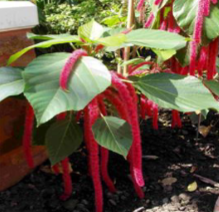Exercise 11: Flowers
1/103
There's no tags or description
Looks like no tags are added yet.
Name | Mastery | Learn | Test | Matching | Spaced |
|---|
No study sessions yet.
104 Terms
Flowers
modified twigs adopted primarily for reproduction, which ultimately forms fruits and seeds; consists of modified leaves
stigma
a.
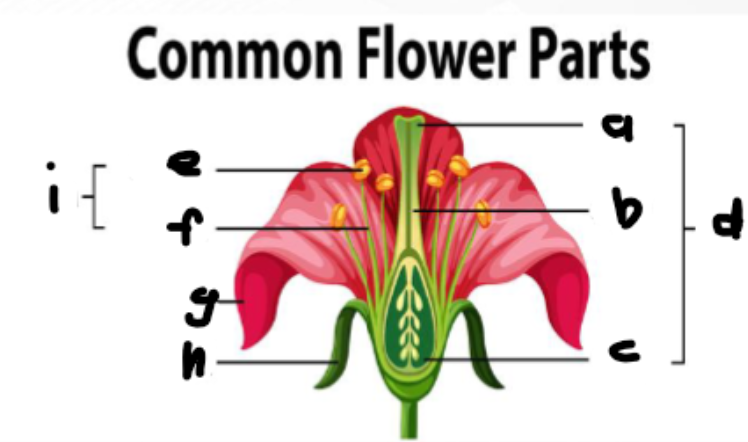
style
b.
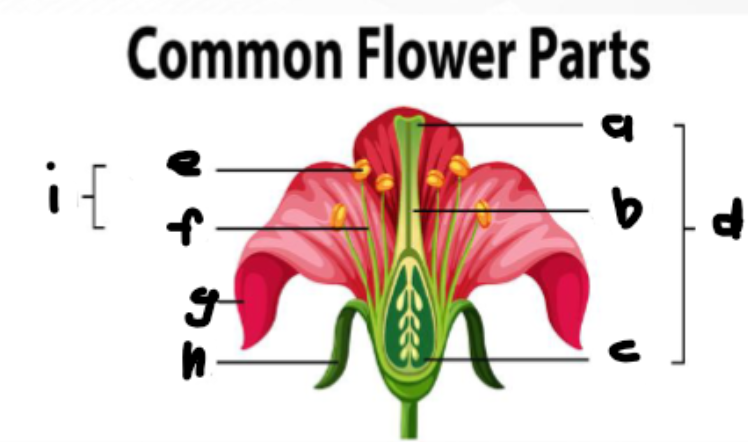
ovary
c.
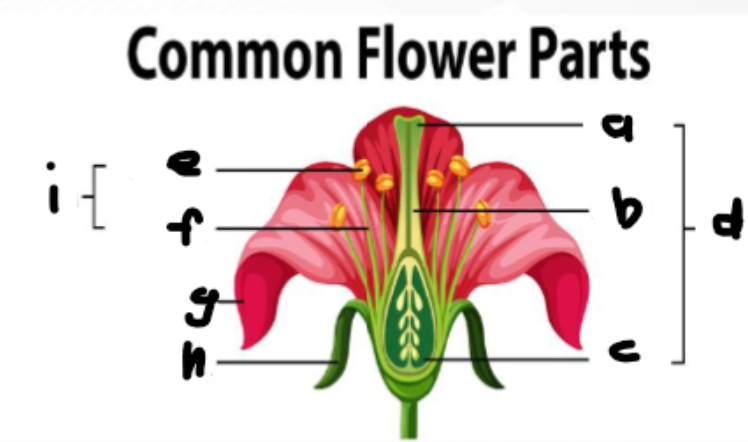
pistil
d.

anther
e.

filament
f.
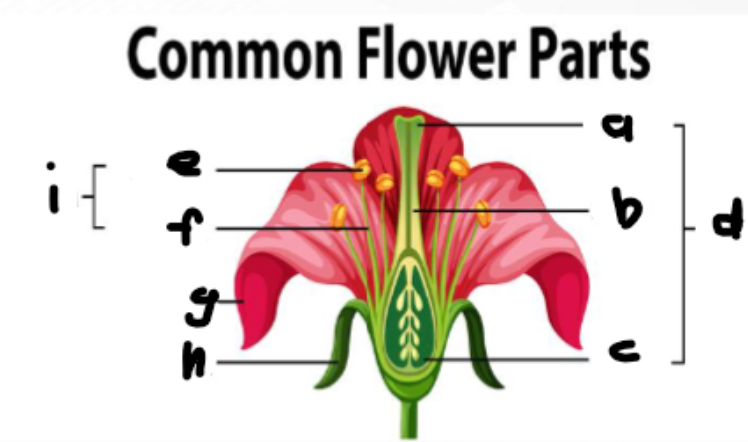
petal
g.
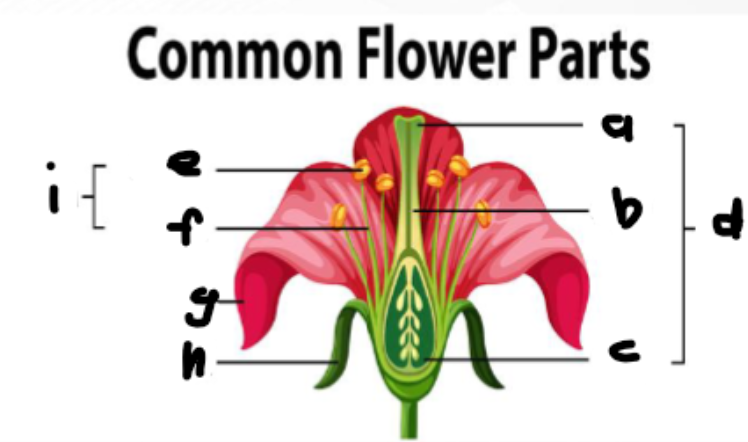
sepal
h.
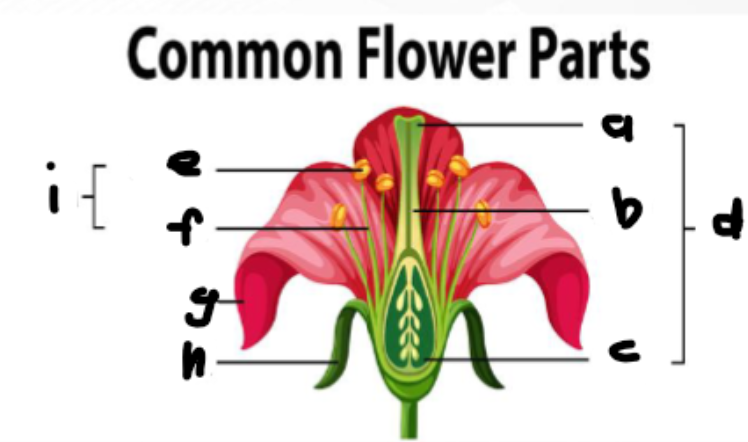
stamen
i.
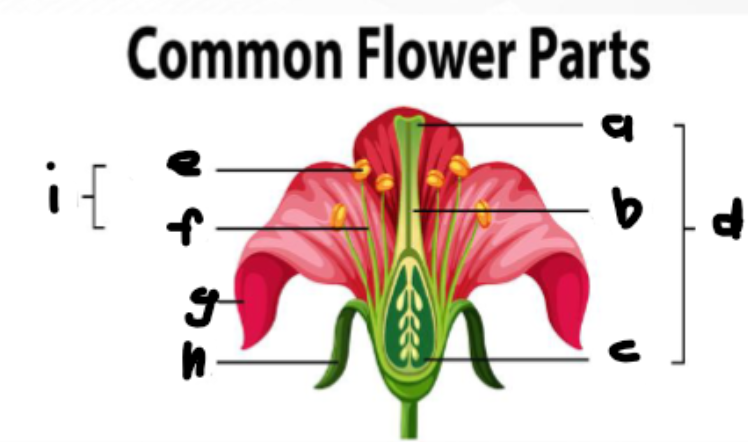
Accessory and Reproductive Parts
2 major parts of a complete flower
Petals and Sepals
composition of accessory parts/flower envelope/perianth
pistil and stamen
composition of reproductive parts
Pistil
female reproductive part
Stigma
slightly enlarged tip of the style on which pollen is deposited at pollination
Cross and Self Pollination
Two types of Pollination
Apis
known as a bee which is a pollinator
Style
long and thin filament that serve as passageway for pollen grains to move from stigma to the ovary
Ovary
swollen basal part of a pistil which carries the ovules in which fertilized eggs developed
Carpel
female reproductive part of a flower which is collectively known as pistil; gynoecium
Pistil
composed of Stigma, Style, and Ovary
Monocarpous
gynoecium has a single carpel
Apocarpous
multiple, distinct (free, unfused) carpel
Syncarpous
multiple fused (connate) into a single structure
Stamen
male reproductive part of a flower; Androecium
Anther
where pollens are formed
Filaments
stalk holding the pollen at its tip
Anther and Filament
composition of the stamen
Petals (Corolla)
innermost whorl surrounding the flowers reproductive parts that are usually brightly colored to attract pollination/pollinators
Receptacle (Torus)
thickened part of a stem from which the flower grows
Peduncle (Pedicel)
stalk supporting the flower
Color
Variable Features and Structure of Flowers that determines if it is a Day or Night Blooming Flowers
Brightly colored
Day blooming flowers are:
White, Cream, Flesh
Night blooming flowers are:
Day Blooming Flowers
Day or Night Blooming? Gerbera
Day Blooming Flowers
Day or Night Blooming? Sunflowers
Night Blooming Flowers
Day or Night Blooming? Dutchman’s Pipe
Odor
Variable Features and Structure of Flowers that is concerned with the sense of smell and aids in attracting pollinators
pleasant
Ilang-Ilang smells?
pungent/unpleasant
Corpse Flower smells?
parts present
In Variable Features and Structure of Flowers, a flower can be complete or incomplete depending on the _______________________
Complete Flower
a flower with the 4 main parts: petal, sepal, pistil, stamen
Incomplete Flower
a flower where one or more of the main parts are not present
Complete
Complete or Incomplete? Gumamela (Hibiscus rosa-sinensis)
Perfect or Imperfect
A flower’s sexuality can be ____________________ or ____________________.
Perfect
A flower’s sexuality is _______ when both stamen and carpel (pistil) is both present; it is bisexual or hermaphroditic
Imperfect
A flower’s sexuality is __________________ if only either stamen or carpel is present; unisexual
Monoecious
both male and female flowers are found on the same plant
Dioecious
imperfect flowers are borne on separate plants
Polygamous
perfect and imperfect flowers are found in a single plant
Rose, Tulips, Gumamela (Mostly angiosperms)
example of a Perfect Flower
Corn
example of an imperfect flower — monoecious
Papaya
example of an imperfect flower — dioecious
Date Palm
example of an imperfect flower — polygamous
Regular
The nature of flower petals when the members of each set of organs are of the same size and shape
Irregular
nature of flower (petals) when some members of one or more set of organs are different in size or shape or both
Orchidaceous
irregular flower with:
a. Sepals (Three outermost whorl)
b. Petals (Two innermost whorl)
c. Lip/Labellum (also a petal but with a different shape and size)
Orchidaceous (Cattleya)
Determine the type of irregular flower and its name
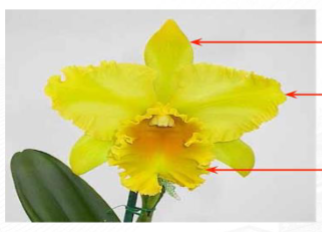
Papillonaceous
irregular flower with:
a. Standard petal/Banner (Outermost and largest part of the flower)
b. Wings/Alae (Two lateral petals)
c. Keels/Carinae (Two innermost and smallest petal)
Papillonaceous (Chicharo)
Determine the type of irregular flower and its name
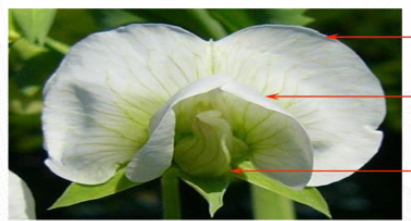
Caesalpinaceous
irregular flower with:
a. Wings (two upper lateral petals)
b. Banner (innermost and smallest petal)
c. Keel (two lower lateral petals)
Caesalpinaceous (Caballero)
Determine the type of irregular flower and its name
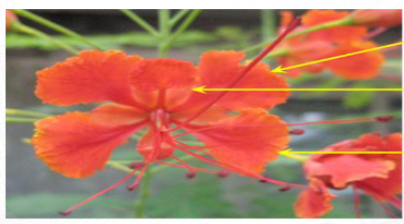
Bilabiate or Two-Lipped
irregular flower with:
a. upper lip
b. lower lip
Bilabiate or Two-Lipped (Sage)
Determine the type of irregular flower and its name
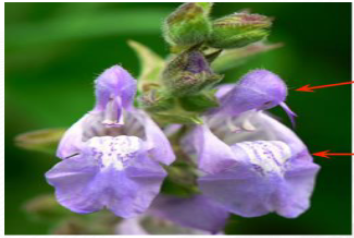
Connation and Adnation
what are the types of fusion of floral plants
Connation
when like parts are fused or united
Adnation
when unlike parts are fused
Monocot
Flower parts in _______________ are in 3’s or multiple of 3’s
Dicot
Flower parts in _______________ are in 4’s or 5’s or multiple of 4’s or 5’s
Benguel Lily
example of monocots that are determined in their number of flower parts
Rosal
example of dicots that are determined in their number of flower parts
Actinomorphic or Zygomorphic
two kinds of symmetry in flowers
Actinomorphic
radial symmetry in which flowers can be divided into 2 equal halves along any plane
Zygomorphic
bilateral symmetry in which flowers can be divided into 2 equal halves only by a medial cut through the central axis
Hypogynous Flower
flowers that have a superior ovary
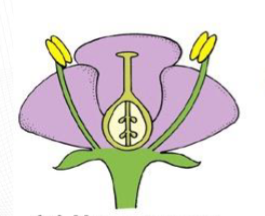
Perigynous Flower
ovary and other parts are the same level

Epigynous Flower
flowers that have an inferior ovary and the other parts are superior
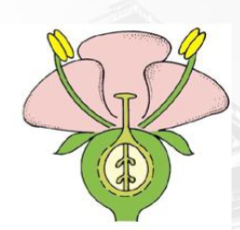
axile
determine the placentation

parietal
determine the placentation

basal
determine the placentation

free-central
determine the placentation

marginal
determine the placentation

apical
determine the placentation

Inflorescence
flower cluster that may differ in the number of flowers borne, the sequence of flower maturation, the length of flower stalk, the number and arrangement of the floral branches or peduncle
Spike
flowers are attached directly to the main axis, without stalks type of inflorescence that has an elongated axis with sessile florets
Spike (Pancit-Pancitan)
type of inflorescence and name of plant
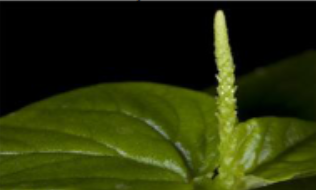
Raceme
type of inflorescence that has an elongated axis is unbranched, the flowers are provided with stalks/pedicle of equal length
Raceme (Golden Shower)
type of inflorescence and the name of the plant
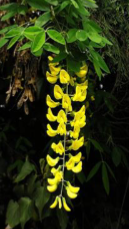
Panicle
Inflorescence in which elongated axis are branched and flowers are pedicellate, opening all at the same time
Panicle (Rice)
type of inflorescence and the name of the plant
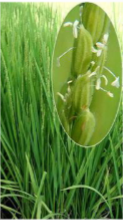
Corymb
inflorescence that has a more/less flat convex top because of the pedicel bearing the outer, older flowers are longer than the younger flowers are at the center
Corymb (Caballero)
type of inflorescence and the name of the plant
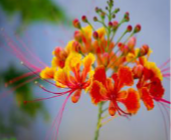
Umbel
type of inflorescence in which the axis is short so that all the pedicellate flowers radiate from the apex of the axis
Umbel (Japanese Bamboo)
type of inflorescence and plant name
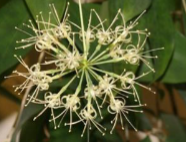
Cyme
inflorescence is similar to a corymb except that the inner pedicelled flowers open first
Cyme (Santan)
type of inflorescence and name of plant name
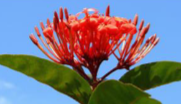
Spadix
inflorescence with a fleshy spike bearing both female and male flowers, surrounded by a petaloid bract called spathe
Spadix (Calla Lily)
type of inflorescence and name of plant
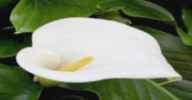
Catkin/Ament
inflorescence is a special type of spike which is hanging/drooping; flower = unisexual
Catkin/Ament (Puntot pusa)
type of inflorescence and name of plant
